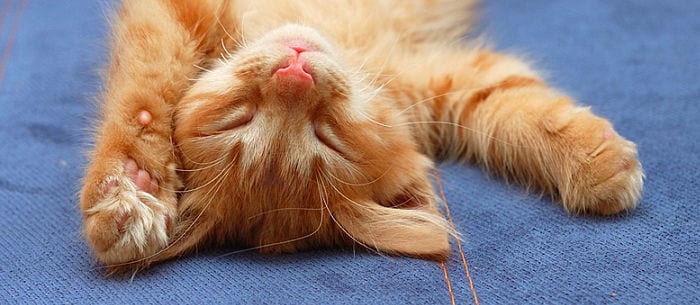Did you just bring home a new cat? How exciting! Ensuring that your pet is as happy and healthy as can be is now going to be one of your main priorities. And one of the most important things you have to do is to make sure that your furry friend gets her required vaccinations. Overwhelmed by all of the different shots available and unsure which ones are actually required? Here’s everything you need to know about cat vaccinations.
“Vaccinations play an important role in the control of infectious diseases for the individual cat, as well as the general cat population,” says Dr. Deborah Carlson, the head veterinarian of the Cat Care Center at Pilchuck Veterinary Hospital in Snohomish, Washington, and the blogger behind The Cat Corner. “A vaccination protocol should be developed by your veterinarian based on your cat’s likelihood of exposure to infectious agents, as well as her health and lifestyle.”
Which Vaccinations Should Your Cat Get First?
The American Association of Feline Practitioners (AAFP) breaks down vaccinations into core and noncore categories. While the core vaccines are recommended for all cats, the noncore shots are only recommended for cats in certain risk groups.
Your veterinarian will start by administering a series of required core vaccinations, which need to be boosted at designated intervals. “Once cats have had their first series of vaccinations against panleukopenia (also known as ‘distemper’) and two upper respiratory viruses, herpesvirus and calicivirus (FVRCP or DRCP vaccine), it needs to be boosted a year later,” says Dr. Margie Scherk, a veterinarian, diplomate of the American Board of Veterinary Practitioners (ABVP) (feline practice) and former president of the AAFP.
This first series can start when your kitten is six weeks old, and boosters should be given every three to four weeks until she is 16 to 20 weeks old, says Dr. Scherk, who serves as a chair of the AAFP Feline Vaccination Advisory Panel. “After that, cats need to be boosted every three years. Adult cats whose vaccination history is unknown should receive a single FVRCP followed by a booster one year later before starting the three-year revaccination schedule.”
According to Dr. Scherk, this series of cat vaccinations is a must for both indoor and outdoor cats, as they protect against “viruses that people can transmit on their hands or clothing.” In fact, an indoor pet may be less protected because his immune system is not exposed to as many viruses on a daily basis. “Indoor cats don’t get regular ‘boosting’ by seeing other cats, therefore may be at greater risk when exposed to cat viruses their people or pet sitters bring home on their hands or clothing,” says Dr. Scherk.
Are There Any Other Core Categories?
The AAFP considers the rabies vaccination a core requirement for cats that live in certain areas. According to Dr. Scherk, the “rabies vaccination is a core vaccine in regions in which rabies is endemic or in which vaccination is legally mandated.”
Your kitten can get this shot as early as 12 weeks old. “As with the other vaccines, after the initial dose has been administered, a subsequent booster is required a year later,” says Dr. Scherk. Afterward, the “boosting interval will depend on the vaccine.” For instance, a three-year vaccine will need to be boosted every three years, while a one-year vaccine will need to boosted every year.
Which Vaccinations Are Optional, but Recommended?
Here are four additional types of vaccines that your vet may recommend, depending on a variety of circumstances.
- Feline Leukemia (FeLV) Vaccine
Feline leukemia is a highly contagious illness that is transmitted through litter boxes, bites and the sharing of food or water bowls. Your kitten can get the first FeLV shot when she is just 8 weeks old. As with many other shots, the FeLV vaccination must be boosted one year after the initial series is administered, explains Dr. Scherk.“The AAFP recommends that thereafter it is boosted every two years for cats at low risk of exposure. Cats that are not at risk for exposure to FeLV should still receive their kitten series and one year booster, however do not require further immunization.” Dr. Scherk recommends that you discuss your cat’s exposure risk with your vet and develop a plan accordingly.
- Feline Immunodeficiency Virus (FIV) Vaccine
As FIV is often transmitted through bite wounds, the vaccination for this disease is a noncore shot that’s recommended for animals who roam outdoors. Your cat can get this shot when she is just eight weeks old, but she will then need two more doses as well as an annual revaccination. - Chlamydophila Felis Vaccine
The most recent AAFP guidelines recommend this vaccine only for cats who are living with other cats who may be infected. - Bordetella Vaccine
Another noncore, the Bordetella vaccine is recommended for cats that live with an infected animal or are housed in high-risk settings, such as shelters.
“Your cat is an individual, and his needs are different from other cats’ needs,” says Dr. Carlson. “Your veterinarian should discuss benefits and risks of the recommended vaccinations with you during your cat’s annual exam. This will allow you to be an active participant in your cat’s health care team.”
Want more information on what you need to do to ensure that your cat grows up to be big and strong? Check out Keeping Your Cat Healthy: All About Caring for Your Pet!
Erica Loop is the mom to one teenager, two Olde Boston Bulldogs and one very shy cat. She’s also a freelance writer, educator and the creator of the blog, Mini Monets and Mommies.
* This article is for general informational purposes only. It is not intended nor implied to be providing medical advice and is not a substitute for such advice. The reader should always consult a health care provider concerning any medical condition or treatment plan. Neither Care.com nor the author assumes any responsibility or liability with respect to use of any information contained herein.





